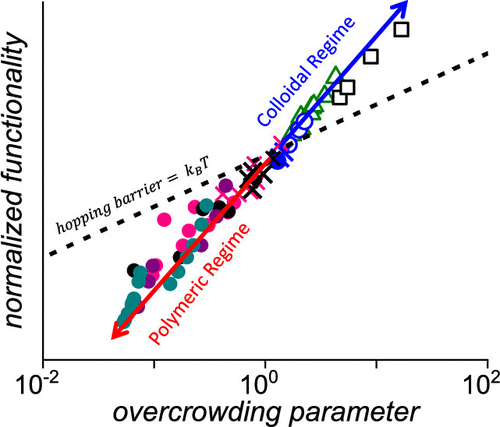Our official English website, www.x-mol.net, welcomes your
feedback! (Note: you will need to create a separate account there.)
Universal Polymeric-to-Colloidal Transition in Melts of Hairy Nanoparticles
ACS Nano ( IF 15.8 ) Pub Date : 2021-10-08 , DOI: 10.1021/acsnano.1c06672 Daniele Parisi 1 , Eileen Buenning 2 , Nikolaos Kalafatakis 1 , Leo Gury 1, 3 , Brian C Benicewicz 4 , Mario Gauthier 5 , Michel Cloitre 3 , Michael Rubinstein 6, 7 , Sanat K Kumar 2 , Dimitris Vlassopoulos 1
ACS Nano ( IF 15.8 ) Pub Date : 2021-10-08 , DOI: 10.1021/acsnano.1c06672 Daniele Parisi 1 , Eileen Buenning 2 , Nikolaos Kalafatakis 1 , Leo Gury 1, 3 , Brian C Benicewicz 4 , Mario Gauthier 5 , Michel Cloitre 3 , Michael Rubinstein 6, 7 , Sanat K Kumar 2 , Dimitris Vlassopoulos 1
Affiliation

|
Two different classes of hairy self-suspended nanoparticles in the melt state, polymer-grafted nanoparticles (GNPs) and star polymers, are shown to display universal dynamic behavior across a broad range of parameter space. Linear viscoelastic measurements on well-characterized silica-poly(methyl acrylate) GNPs with a fixed core radius (Rcore) and grafting density (or number of arms f) but varying arm degree of polymerization (Narm) show two distinctly different regimes of response. The colloidal Regime I with a small Narm (large core volume fraction) is characterized by predominant low-frequency solidlike colloidal plateau and ultraslow relaxation, while the polymeric Regime II with a large Narm (small core volume fractions) has a response dominated by the starlike relaxation of partially interpenetrated arms. The transition between the two regimes is marked by a crossover where both polymeric and colloidal modes are discerned albeit without a distinct colloidal plateau. Similarly, polybutadiene multiarm stars also exhibit the colloidal response of Regime I at very large f and small Narm. The star arm retraction model and a simple scaling model of nanoparticle escape from the cage of neighbors by overcoming a hopping potential barrier due to their elastic deformation quantitatively describe the linear response of the polymeric and colloidal regimes, respectively, in all these cases. The dynamic behavior of hairy nanoparticles of different chemistry and molecular characteristics, investigated here and reported in the literature, can be mapped onto a universal dynamic diagram of f/[Rcore3/ν0)1/4] as a function of (Narmν0f)/(Rcore3), where ν0 is the monomeric volume. In this diagram, the two regimes are separated by a line where the hopping potential ΔUhop is equal to the thermal energy, kBT. ΔUhop can be expressed as a function of the overcrowding parameter x (i.e., the ratio of f to the maximum number of unperturbed chains with Narm that can fill the volume occupied by the polymeric corona); hence, this crossing is shown to occur when x = 1. For x > 1, we have colloidal Regime I with an overcrowded volume, stretched arms, and ΔUhop > kBT, while polymeric Regime II is linked to x < 1. This single-material parameter x can provide the needed design principle to tailor the dynamics of this class of soft materials across a wide range of applications from membranes for gas separation to energy storage.
中文翻译:

多毛纳米颗粒熔体中的通用聚合物-胶体转变
两种不同类型的熔融状态的毛状自悬浮纳米粒子,聚合物接枝纳米粒子 (GNP) 和星形聚合物,在广泛的参数空间中显示出普遍的动态行为。对具有固定核心半径 ( R core ) 和接枝密度 (或臂数f ) 但臂聚合度 ( N arm ) 不同的充分表征的二氧化硅-聚 (丙烯酸甲酯) GNP 的线性粘弹性测量显示了两种截然不同的方案回复。具有小N臂(大核心体积分数)的胶体状态 I 的特征是主要的低频固体状胶体平台和超慢弛豫,而具有大的聚合物状态 IIN臂(小核心体积分数)具有由部分互穿臂的星状弛豫主导的响应。两种模式之间的过渡以交叉为标志,尽管没有明显的胶体平台,但可以识别出聚合物和胶体模式。类似地,聚丁二烯多臂星在非常大的f和小的N臂上也表现出政权 I 的胶体响应. 在所有这些情况下,星臂回缩模型和纳米粒子通过克服由于其弹性变形而产生的跳跃势垒从邻居笼中逃逸的简单缩放模型分别定量地描述了聚合物和胶体状态的线性响应。在此研究并在文献中报道的不同化学和分子特性的毛状纳米粒子的动态行为可以映射到f /[ R core 3 /ν 0 ) 1/4 ] 作为 ( N的函数的通用动态图臂ν 0 f )/( R核心3 ),其中 ν 0是单体体积。在该图中,两个状态由一条线隔开,其中跳跃电势 ΔU hop等于热能k B T。ΔU hop可以表示为过度拥挤参数x的函数(即f与可以填充聚合物冠所占据的体积的具有N臂的未扰动链的最大数量之比);因此,当x = 1 时,会发生这种交叉。对于x > 1,我们有胶体状态 I,体积过大,臂伸长,Δ U hop > k BT,而聚合物体系 II 与x < 1 相关联。这种单一材料参数x可以提供所需的设计原则,以在从气体分离膜到能量存储的广泛应用中定制这类软材料的动力学。
更新日期:2021-10-26
中文翻译:

多毛纳米颗粒熔体中的通用聚合物-胶体转变
两种不同类型的熔融状态的毛状自悬浮纳米粒子,聚合物接枝纳米粒子 (GNP) 和星形聚合物,在广泛的参数空间中显示出普遍的动态行为。对具有固定核心半径 ( R core ) 和接枝密度 (或臂数f ) 但臂聚合度 ( N arm ) 不同的充分表征的二氧化硅-聚 (丙烯酸甲酯) GNP 的线性粘弹性测量显示了两种截然不同的方案回复。具有小N臂(大核心体积分数)的胶体状态 I 的特征是主要的低频固体状胶体平台和超慢弛豫,而具有大的聚合物状态 IIN臂(小核心体积分数)具有由部分互穿臂的星状弛豫主导的响应。两种模式之间的过渡以交叉为标志,尽管没有明显的胶体平台,但可以识别出聚合物和胶体模式。类似地,聚丁二烯多臂星在非常大的f和小的N臂上也表现出政权 I 的胶体响应. 在所有这些情况下,星臂回缩模型和纳米粒子通过克服由于其弹性变形而产生的跳跃势垒从邻居笼中逃逸的简单缩放模型分别定量地描述了聚合物和胶体状态的线性响应。在此研究并在文献中报道的不同化学和分子特性的毛状纳米粒子的动态行为可以映射到f /[ R core 3 /ν 0 ) 1/4 ] 作为 ( N的函数的通用动态图臂ν 0 f )/( R核心3 ),其中 ν 0是单体体积。在该图中,两个状态由一条线隔开,其中跳跃电势 ΔU hop等于热能k B T。ΔU hop可以表示为过度拥挤参数x的函数(即f与可以填充聚合物冠所占据的体积的具有N臂的未扰动链的最大数量之比);因此,当x = 1 时,会发生这种交叉。对于x > 1,我们有胶体状态 I,体积过大,臂伸长,Δ U hop > k BT,而聚合物体系 II 与x < 1 相关联。这种单一材料参数x可以提供所需的设计原则,以在从气体分离膜到能量存储的广泛应用中定制这类软材料的动力学。











































 京公网安备 11010802027423号
京公网安备 11010802027423号